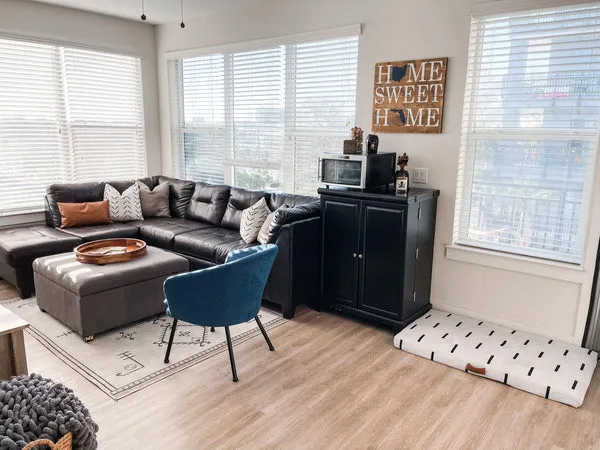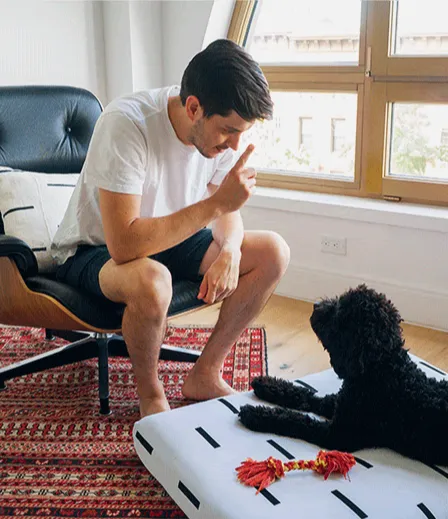For many dog owners, the living room couch is a prime spot for relaxation and bonding with their furry companions. However, for some, the idea of a dog on the furniture is a strict no-go. Whether you’ve just welcomed a new puppy or have an older dog with established habits, setting clear boundaries regarding furniture access is a crucial part of responsible dog ownership. The good news is that training your dog to stay off the furniture is a manageable process that, with consistency and the right approach, can yield significant results within a few days. This guide will provide you with effective strategies to help your dog understand and respect your furniture rules, ensuring a harmonious living environment for everyone.
One of the most effective ways to begin shaping your dog’s behavior around furniture is by understanding their motivations and providing clear, consistent guidance. It’s important to remember that dogs thrive on routine and clear communication. When they understand what is expected of them, they are more likely to comply. This process not only teaches them to avoid certain areas but also strengthens the bond between you and your dog through positive reinforcement and clear communication. For those looking to deepen their understanding of canine behavior and training, exploring resources on how to train your dog to help with your anxiety can offer valuable insights into building a strong, responsive relationship.
 A German Shepherd sleeping on a couch
A German Shepherd sleeping on a couch
The Blockade Method: Physical Barriers for Immediate Results
The Blockade Method is a straightforward and highly effective approach, particularly for preventing immediate access. The core principle is simple: if your dog cannot physically reach the furniture, they won’t be tempted to jump on it. When you are present, this can involve literally occupying the space on the couch yourself. If there’s no room for your dog to comfortably jump up, they are less likely to try.
Beyond your physical presence, you can utilize various physical deterrents to create an inaccessible zone. Baby gates are excellent for blocking off entire rooms or specific furniture items. Large, sturdy objects can also serve this purpose. If you’re concerned about aesthetics, there are stylish decorative dividers or sturdy pet gates available that can blend seamlessly with your home décor. Another creative solution is to strategically stack pillows or move ottomans to create a physical barrier. The goal is to make entering the furniture a prohibitive action for your dog.
 A dog looking at a couch with a baby gate in front of it
A dog looking at a couch with a baby gate in front of it
The “Off” Command: Teaching Appropriate Behavior
While the Blockade Method is excellent for immediate prevention, it doesn’t teach your dog the underlying behavior. To achieve lasting results, you need to actively teach your dog the desired commands. The most crucial commands in this context are “off” and, for those who wish to allow occasional couch time, “up.”
To teach the “off” command, observe your dog’s behavior. The moment your dog jumps onto the furniture, approach them with a high-value treat or their favorite toy. Calmly say “off” and use the reward to lure them down to the floor. Consistently reward this behavior with praise and the treat. With repeated practice, your dog will begin to associate the word “off” with leaving the furniture. This positive reinforcement is key to helping them understand what you want.
 A dog being lured off a couch with a treat
A dog being lured off a couch with a treat
For owners who want their dog to be able to join them on the couch on invitation, teaching the “up” command is beneficial. You might need a leash for this. With your dog on leash, excitedly say “up!” and pat the area on the couch where you want them to jump. Use a toy or treat to entice them. If they hesitate, a gentle upward tug on the leash can guide them. Once they are on the couch, lavish them with praise and a reward. This method, combined with consistent practice of the “off” command, teaches your dog that furniture access is granted, not assumed. This approach to selective furniture access can be a part of a broader training regimen, and for those interested in understanding how to train your own service dog for anxiety, the principles of clear communication and positive reinforcement are fundamental.
 A dog on a couch with a blanket
A dog on a couch with a blanket
The “Place” or “Bed” Command: Offering an Attractive Alternative
Another highly effective strategy is to provide your dog with a desirable alternative to the couch. This is where the “place” or “bed” command comes into play. By designating a comfortable dog bed in the same vicinity as the couch, you offer your dog a clear choice. Many modern dog beds are designed to be stylish accessories, ensuring they complement your home décor rather than detract from it.
When you notice your dog approaching the couch, use the “place” command and gently guide them towards their bed. You can use small treats scattered along the path to their bed to reinforce the positive direction. For dogs who are more resistant, a leash can be used to gently guide them to their designated spot. As your dog becomes more responsive to the “place” command, you can gradually phase out the treats for simply going to their bed.
To solidify the “off the couch” rule, shift your reinforcement strategy. When you are in the room with the couch, actively reward your dog for choosing their bed over the furniture. This positive reinforcement solidifies the sofa as an off-limits zone and their bed as the preferred resting place. This method of providing clear alternatives and positive reinforcement is invaluable for building a well-behaved dog, and understanding how to teach your dog deep pressure therapy can further enhance your training toolkit.
 A dog resting on a dog bed next to a couch
A dog resting on a dog bed next to a couch
Maintaining Consistency When You’re Away
It’s a common frustration for dog owners: a perfectly behaved dog when you’re home, only to discover they’ve commandeered the couch the moment you step out. Security camera footage often reveals this sneaky behavior. The most effective way to prevent your dog from jumping on the furniture when you’re not around is through continued access prevention.
This can involve placing a baby gate in the hallway leading to the living room, or, for a more comprehensive solution, implementing crate training. Crate training, while sometimes challenging, can be a valuable tool for preventing destructive behavior and ensuring your dog remains off furniture when unsupervised. Many owners find that using their dog’s comfortable bed within the crate can make the experience more positive and aids in the training process. Exploring resources on how to crate train your dog can provide detailed guidance for this method.
If crating isn’t feasible for your situation, consider using safe deterrents. These can help discourage your dog from jumping on the furniture and can be evaluated for effectiveness with your specific dog.
Regardless of the method you choose, remember that consistency and steadfastness are paramount. Mixed signals will only confuse your dog and hinder progress. Ensure that all members of your household are on the same page regarding the training rules and consistently apply them. Reinforcement of desired behaviors is key to long-term success.
For those seeking professional guidance to train their dog from home, enrolling in an online dog training program can provide expert instruction and a structured learning environment. If you’re exploring the possibility of training a service dog yourself, understanding these fundamental training principles is essential, and there are resources available on whether you can train a service dog yourself.
References:
- WagWalking. (n.d.). How to Train Your Dog to Stay Off the Furniture. Retrieved from https://wagwalking.com/training/stay-off-the-furniture
- Laylo. (n.d.). Dog Beds & Bed Covers. Retrieved from https://www.laylopets.com/collections/all
- Laylo. (n.d.). How to Crate Train Your Dog. Retrieved from https://www.laylopets.com/blogs/barkives/how-to-crate-train-your-dog
- Laylo. (n.d.). Home School – Online Dog Training. Retrieved from https://www.laylopets.com/pages/homeschool
